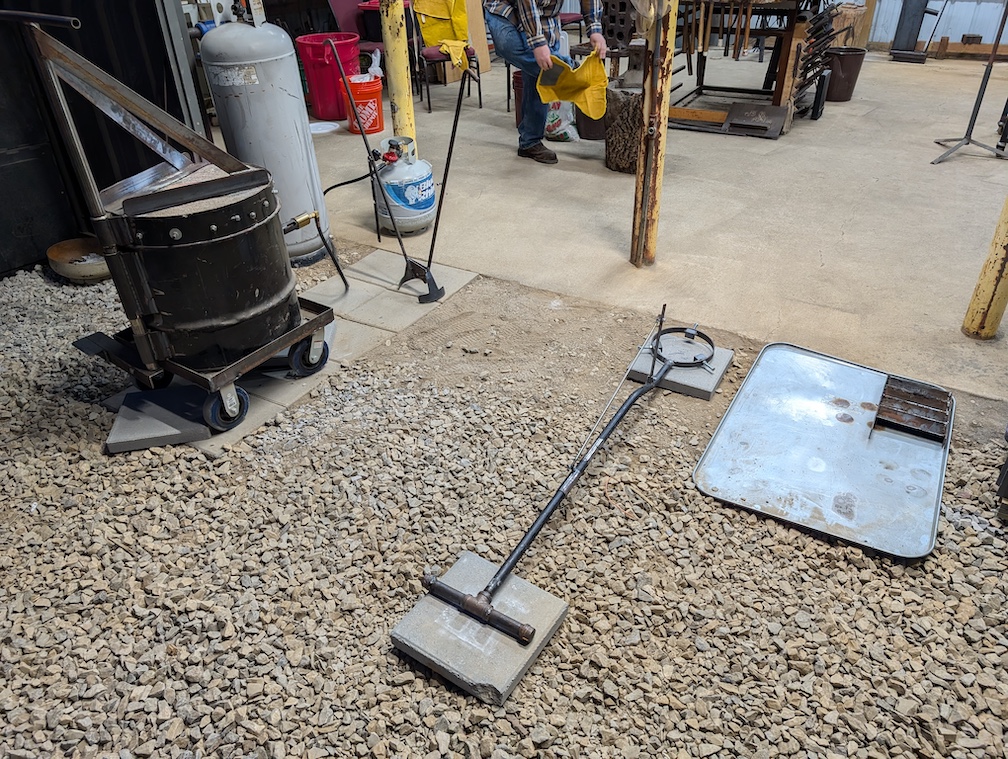Foundry
WORK IN PROGRESS
The Foundry is a tool housed within Blacksmithing zone and can only be used practically if you have the Blacksmithing auth, which is required to get a key to the blacksmithing building.
Safety
Gear
Working in a foundry is very dangerous! We provide safety gear to help reduce the odds of your getting hurt. To use the foundry, you must wear the following:
- Safety glasses, ideally shaded to protect your eyes
- A face screen to protect your face
- Closed-toed shoes (steel toes aren't a bad idea)
- Long sleeves and pants in natural fibers (cotton, flannel). We recommend borrowing a welding shirt from Metalworking.
- Heat-resistant spats to protect your shins and feet
- Heat-resistant gloves
- Ear protection if the noise bothers you
Everything you do in the foundry must be very intentional. Place each step carefully, double check that no one is too close for your personal comfort (and their safety), move methodically and consistently when possible.
Fumes
Any time you heat up metal, you run the risk of releasing toxic fumes. It's important to know what metal you're using and what the signs suggest that you have inhaled the fumes. We pour outside the building in part to give fumes more room to disperse, but you should look out for smoke coming from the furnace and adjust your position or ventilation as needed. If you have one, you might like to wear a respirator. Below you'll find a few common types of fumes to beware of.
Zinc fumes
- Commonly released when casting metals like brass.
- Short-term exposure can cause flu-like symptoms (known as metal fume fever), nausea, headaches, and muscle aches.
- Long-term exposure may lead to chronic respiratory issues, such as asthma or other lung damage.
Carbon monoxide
- Released during incomplete combustion of fuels.
- Exposure can lead to dizziness, confusion, or even unconsciousness in severe cases.
- Long-term exposure can cause heart and brain damage due to oxygen deprivation.
Sulfur dioxide
- Released during the casting of metals like iron and copper.
- Short-term exposure can irritate the respiratory system, causing coughing, shortness of breath, and a burning sensation.
- Long-term exposure may lead to chronic lung disease or aggravation of pre-existing conditions like asthma.
Hydrogen chloride
- Released when metals like zinc or copper are cast.
- Causes severe irritation to the eyes, skin, and respiratory tract.
- Long-term exposure can result in chronic bronchitis or permanent lung damage.
Setup
Wheel the furnace out onto a flat surface just outside the front door of the blacksmith shop. There should be pavers set out that you can park the furnace on. Block the wheels with something that will prevent the furnace from moving (one day, we may add chucks or locking wheels).
There should be a propane tank near the furnace, but note that the propane tank should stay inside the shop door while the furnace should be outside the door. Think about how you'll move around the furnace with the tongs and molten metal. Here's a layout that worked well in testing:
Note that the furnace is sitting on pavers on the gravel. The propane tank is inside the shop. Between the propane and the furnace are the tongs for lifting the crucible out of the furnace. Lying on pavers in the middle of the photo are the pouring tongs. At right is a sheet of metal that you'll set your molds on to pour into. In the upper right corner of the metal is a mold to pour any leftover metal into so that we can melt it down again for a future pour. This arrangement lets you maneuver from furnace to tongs to pouring area with a reduced likelihood of getting tripped up.

